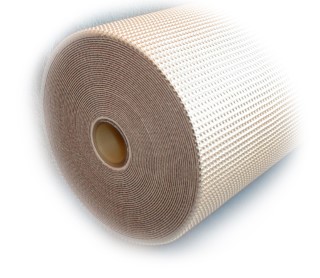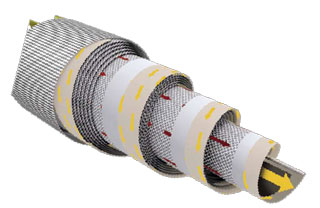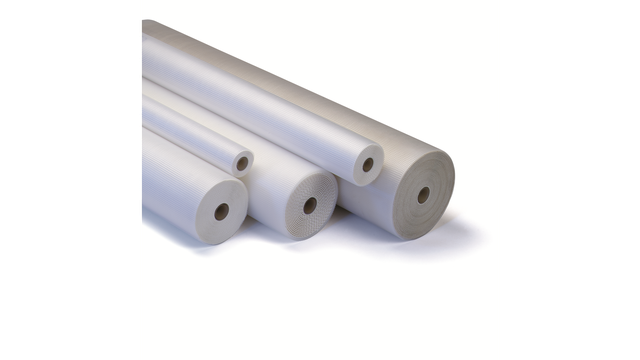Espiral UF
The ultrafiltration spiral membranes from Alfa Laval are based on a unique construction of either polypropylene or polyester support material in a hygienic full-fit design that provides optimum cleaning conditions. The spiral membranes are available with different ultrafiltration membrane types and in different combinations of length, diameter and feed spacer size
The pores of the membranes used for Alfa Laval ultrafiltration spiral membranes are small, having a cut-off range from 1,000 to 100,000 molecular weight (MWCO), and the applied pressure is relatively low. Salts, sugars, organic acids and smaller peptides pass through the pores of the membrane, whereas proteins, fats and polysaccharides are retained.
Using appropriate ultrafiltration membranes also makes it possible to fractionate a feed stream into two distinct streams, with each stream containing dissolved components with different molecular weights.
The Alfa Laval ultrafiltration spiral membranes are a popular choice for many processes applied in the food, beverage, dairy, biotech and pharmaceutical industries where they are used for product recovery for example of an active from fermentation broth, as well as product purification, fractionation and concentration.
Alfa Laval offers a comprehensive range of spiral membranes with different characteristics and properties.
UF-ETNA series
The ETNA ultrafiltration membrane is made of composite fluoro polymer membrane cast on polypropylene (PP) backing material. The UF-ETNA spiral membrane is available in two types: ETNA01PP and ETNA10PP having a molecular weight cut-off value (MWCO) of 1,000 and 10,000 dalton respectively.
UF-FS series
This ultrafiltration membrane is also made of composite fluoro polymer membrane cast on polypropylene backing material. The UF-FS spiral membrane is available as FS40PP with a MWCO value of 100,000 dalton.
UF-PE series
This series of ultrafiltration spiral membranes from Alfa Laval is tailor-made for the dairy and beverage industries, but it is also a popular choice for other food, chemical and pharmaceutical applications.
The UF-PE membrane is made of either polysulphone or polyethersulphone membrane on polyester (PET) support material. The UF-PE spiral membrane is available in the following types: GR60PE, GR61PE, GR70PE, GR73PE and GR82PE with MWCO values ranging from 25,000 to 5,000 dalton.
UF-pHt series
The UF-pHt membrane is characterized by its tolerance towards high pH and temperature. It is made of polysulphone or polyethersulphone membrane cast on polypropylene backing material. Similar to the UF-PE series the UF-pHt spiral membrane is available in the types GR60PP, GR61PP, GR70PP, GR73PP and GR82PP with MWCO values between 25,000 and 5,000 dalton.
UF-RC series
The RC ultrafiltration membrane is made of regenerated cellulose membrane cast on polypropylene support material. The UF-RC spiral membrane is available as RC70PP having a MWCO value of 10,000 dalton.
UFX-pHt series
The UFX-pHt ultrafiltration membranes is also characterized by its ability to tolerant high pH and temperatures. The membrane is made of polysulphone permanently hydrophilic, cast on polypropylene support material. The UF-pHt spiral membrane is available as UFX10 pHt with a MWCO value of 10,000.
Benefits
- cost-effective operation due to low energy consumption
- long life time compared to traditional dead-end filtration
- cover a broad spectrum of flux properties and pore sizes
- available in different combinations of length, diameter and spacer size
- sanitary design with all materials in compliance with EU Regulation (EC) 1935/2004, EU Regulation 10/2011 and FDA regulations (CFR) Title 21
- same membrane types available as both flat sheet membranes and spiral membranes
- suitable for extensive range of processes
- manufactured by Alfa Laval's own membrane centre

Cómo funciona
La tecnología básica tras filtración por membrana implica el uso de una membrana semipermeable para separar un líquido en dos corrientes distintas.
El bombeo de este líquido a través de la superficie de la membrana crea una presión transmembrana positiva que permite el paso de cualquier componente más pequeño que la porosidad de la membrana, formando el permeado.
Cualquier componente más grande que el tamaño del poro no puede pasar y queda atrás en lo que llamamos retenido. La superficie de la membrana se mantiene libre de bloqueos por la fuerza del flujo de líquido que se mueve en paralelo a la superficie de la membrana.
Una membrana en espiral se compone de una serie de «sobres» de membrana con 2 láminas de membrana separadas por una malla espaciadora de permeado, cada una pegada a un tubo central de recolección de permeado.

Entre cada par de envolturas hay un separador que crea el canal de alimentación, permitiendo que la alimentación fluya a lo largo de la membrana en espiral, mientras que el permeado que pasa a través de la membrana hacia la envoltura de la membrana fluye en un patrón en espiral hacia el tubo de recolección de permeado.
Rojo = Alimento/retenido.
Amarillo = Permeado.

